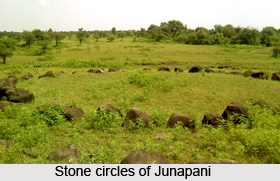 Stone circles of Junapani, situated near Nagpur city of Maharashtra, are designated as the monuments of national significance by the Archaeological Survey of India (ASI). These are prehistoric megalithic circles that numbers about 150 in this region. These stone circles were first of all discovered in the year 1879 by J. H. Rivett-Carnac which also revealed a number of iron objects such as pointed tongs, chisels with long blades, horse bits, bracelets, rings, hoes, flat axes having cross-ring fasteners and daggers. Evidences of red and black pottery have also been found which include bowls with black linear paintings. Cairns were prominent in the burial sites. ASI unveiled this site in the year 1962 with 3 stone circles. Further studies of stone circles were funded by Tata Institute of Fundamental Research (TIFR).
Stone circles of Junapani, situated near Nagpur city of Maharashtra, are designated as the monuments of national significance by the Archaeological Survey of India (ASI). These are prehistoric megalithic circles that numbers about 150 in this region. These stone circles were first of all discovered in the year 1879 by J. H. Rivett-Carnac which also revealed a number of iron objects such as pointed tongs, chisels with long blades, horse bits, bracelets, rings, hoes, flat axes having cross-ring fasteners and daggers. Evidences of red and black pottery have also been found which include bowls with black linear paintings. Cairns were prominent in the burial sites. ASI unveiled this site in the year 1962 with 3 stone circles. Further studies of stone circles were funded by Tata Institute of Fundamental Research (TIFR).
History of Stone Circles of Junapani
Junapani has been inhabited since 1000 BC till the present time and the megaliths of stone circles dates back to 1000 BC to 300 AD. Numerous other artefacts have also been excavated from this region which belongs to megalithic period. The iron objects found here essentially belong to 1000 BC and the local communities of various clans have helped in their identification. 150 stone circles in Junapani makes this site the second largest, among which 89 have been found in Vidharba region and 51 around Nagpur region. Out of the three circles that were initially excavated, two had unearthed human remains with funerary objects. Along with these an animal skeleton of horse family was also found. Some of the stones in these circles were cup-marked which represent astronomical significance. These cup marked stones were however found at specific locations which indicate definite directions.
Discoveries of Stone Circles of Junapani
The region of stone circles of Junapani has furnished various funerary antiquities. Excavations of this megalithic burial site have revealed painted red pottery among which some bear Megalithic Graffiti Symbols. Apart from this, coarse red and micaceous red wares have also been found. Elaborate studies of about 56 stone circles have been done by Archaeological Survey of India, most of which have been preserved in a good state. Cup marks have been found in about 20 circles among which 7 have marks on their sides. Some of the stone have cup marks with orthogonal sequences or parallel lines which are arranged in straight line. All the cup marks bear a definite angular range which forms 3 clusters. These marks are generally a few centimetres long and are oriented towards the sky making a definite angle with north direction. Investigations have established the probability of their stellar orientation and show changing weathers in different seasons, the time of rising and setting for specific stars and advent of monsoon season. Another interesting artefact found in one of the circles is a copper bell having an iron tongue. Piles of sticky black clay have been found in three circles. Numerous iron implements excavated have credited this site as `iron-using`. Other antiquities are Middle Stone Age tools and stone pestles.



















